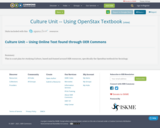
This is a unit plan for studying Culture, based and framed around OER resources, specifically the OpenStax textbook for Sociology.
- Subject:
- Social Science
- Material Type:
- Unit of Study
- Date Added:
- 01/29/2018

This is a unit plan for studying Culture, based and framed around OER resources, specifically the OpenStax textbook for Sociology.

Short Description:
The Local Development and Local Opportunities book is one of the first of its kind, in particular in the context of development of the small Anatolian cities. The book, on one hand, discusses opportunities offered by the small Anatolian cities; and on the other hand, shares new proposals for potential development programs.
Long Description:
The Local Development and Local Opportunities book is one of the first of its kind, in particular in the context of development of the small Anatolian cities. The book, on one hand, discusses opportunities offered by the small Anatolian cities; and on the other hand, shares new proposals for potential development programs. The book, as the last in a series of new academic activities between 2016-2018, is related to development concerns in a self-organized small city in the Eastern Anatolia.
Word Count: 4270
(Note: This resource's metadata has been created automatically by reformatting and/or combining the information that the author initially provided as part of a bulk import process.)
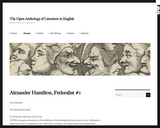
AFTER an unequivocal experience of the inefficiency of the subsisting federal government, you are called upon to deliberate on a new Constitution for the United States of America. The subject speaks its own importance; comprehending in its consequences nothing less than the existence of the union, the safety and welfare of the parts of which it is composed, the fate of an empire in many respects the most interesting in the world. It has been frequently remarked that it seems to have been reserved to the people of this country, by their conduct and example, to decide the important question, whether societies of men are really capable or not of establishing good government from reflection and choice, or whether they are forever destined to depend for their political constitutions on accident and force. If there be any truth in the remark, the crisis at which we are arrived may with propriety be regarded as the era in which that decision is to be made; and a wrong election of the part we shall act may, in this view, deserve to be considered as the general misfortune of mankind.
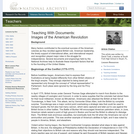
This lesson focuses on the American Revolution, which encouraged the founding fathers' desire to create a government that would, as stated in the Preamble, insure domestic tranquility and provide for the common defense. This lesson correlates to the National History Standards and the National Standards for Civics and Social Sciences.
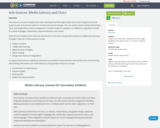
This resource includes multiple lesson plans developed by Washington State teacher John Zingale and can be taught as part of in-person, hybrid, or remote instructional settings. The core content areas include social studies, civics, and media literacy and are designed for use with students in grades 6-12. Additional integrations include ELA, world languages, mathematics, physical education and science. These lessons integrate both state and national civics instruction using project-based and collaborative learning strategies. Features of these lessons include:student researchcollaborative learningdigital learning strategieslateral readingdesign and creation of infographicsTo support these lessons, additional resources are provided to help educators and families with understanding and teaching information and media literacy to young people. Resources include:introductions to media literacyeducator guidesparent guidesstudent learning standards
![Lenses of Vietnam: Protest in a Democracy [Inquiry Design Model (IDM) Unit Plan]](https://img.oercommons.org/160x134/oercommons/media/courseware/lesson/image/22Photograph_of_a_Female_Demonstrator_Offering_a_Flower_to_a_Military_Police_Officer22_by_Albert_R._Simpson_uOQkEc8.gif)
This inquiry takes students through an analysis and evaluation of the Compelling Question “Is protest important in a democracy?” using the Vietnam War as a lens to approach the topic. To accomplish this, students will become more media literate through evaluating sources, biases, perspectives, and the goals of creating media. Throughout the inquiry, students will engage in activities designed to promote and develop media literacy while analzying the Compelling Question and learning about the historical protests of the Vietnam Era.This inquiry is expected to take two weeks (10 periods) to complete: one 45-minute class period to stage the question, introduce the inquiry, and to review media literacy; two 45-minute class periods for each of the three supporting questions; and then three 45-minute class periods for students to write and research their argumentative thesis. If students are as of yet less familiar with media literacy, the instructor should add at least another class period, or more, introducing them more fully to this.The full unit, along with all materials and resources, is available as a PDF attachment.

Students will learn about the attack on Pearl Harbor and the US response of the Pearl Harbor Day observance.

In the first bend of this unit, students will closely read multiple perspectives on the “American Dream” in
order to collect information to use and integrate that information into an evidence-based perspective.
Students will examine primary and secondary source documents to make informed decisions about
what information to collect that may inspire their writing about “The American Dream.”
In the second bend of this unit, students will engage in a short-research process to create a draft of
argumentative speech on the “American Dream” with a specific purpose, audience, and tone in mind.
They will use their inquiry research questions from bend one to begin analyzing search results and citing
and gathering relevant, accurate, and credible information.
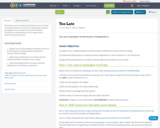
This lesson uses secondary and primary sources as well as statistical historical records to understand, interpret and apply the core elements of the United States Declaration of Independence to its origins and in modern American society.
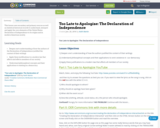
This lesson uses secondary and primary sources as well as statistical historical records to understand, interpret and apply the core elements of the United States Declaration of Independence to its origins and in modern American society.
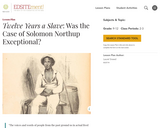
This lesson focuses on the slave narrative of Solomon Northup, a free black living in the North, who was kidnapped and sold into slavery in the Deep South. Slave narratives are autobiographies of former slaves that describe their experiences during enslavement, how they became free, and their lives in freedom. Because slave narratives treat the experience of one person, they raise questions about whether that individual's experiences exceptional.
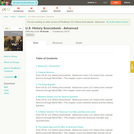
From CK-12, U.S. History Sourcebook - Advanced covers U.S. history from Colonial America through World War I. This book provides high school U.S. History teachers and students with sets of primary and secondary sources about important topics. Some teachers will use it as a supplement to a traditional textbook. For those looking to leave the textbook behind entirely, it will provide a course with basic structure and continuity, and will reduce the burden of finding new primary sources for each class meeting. However, it is not yet comprehensive enough to meet the coverage requirements of, for example, an Advanced Placement test.

From CK-12, U.S. History Sourcebook - Basic covers U.S. history from Colonial America through World War I. This book provides high school U.S. History teachers and students with sets of primary and secondary sources about important topics. Some teachers will use it as a supplement to a traditional textbook. For those looking to leave the textbook behind entirely, it will provide a course with basic structure and continuity, and will reduce the burden of finding new primary sources for each class meeting. However, it is not yet comprehensive enough to meet the coverage requirements of, for example, an Advanced Placement test.
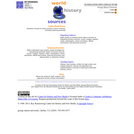
World History teachers face many challenges to incorporating primary sources in their teaching—the pressures of coverage in survey courses, the lack of available materials, and inadequate training in dealing with unfamiliar sources from a range of cultures. World History Sources responds to these challenges (as well as the new opportunities offered by the Internet) by creating a website to help world history teachers and students locate, analyze, and learn from online primary sources and to further their understanding of the complex nature of world history, especially the issues of cultural contact and globalization. This site includes scholarly reviews of online primary source archives, including teaching potential; Eight guides by leading world history scholars to analyzing primary sources: music, images, objects, maps, newspapers, travel narratives, official documents, and personal accounts; Eight multimedia case studies model strategies for interpreting particular types of primary sources (music, images, objects, maps, newspapers, travel narratives, official documents, personal accounts) and placing them in historical context; Sixteen case studies, written by high school and college teachers, discuss the planning and implementation involved in teaching a particular primary source.